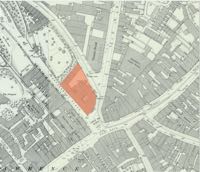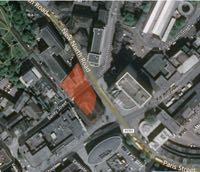
- Home
- Memories
- Scrapbook ▽
- Topics ▽
- People ▽
- Events
- Photos
- Site Map
- Timeline
Page updated 11th February 2019
Back to Pubs of Exeter
Also see
London Inn Square
 The New London Inn, was
considered in its time to
be one of the most luxurious inns in the city. Built in 1793-94 for Mr
John Land, who had previously owned the Half Moon Inn and the Old
London Inn (Bude Hotel), elsewhere in the city. The architects were
Matthew and Thomas Nosworthy, who were responsible for building Dix's
Field and Barnfield Crescent. The inn which was built on the site
of the Oxford Inn, which had closed in March 1790, had an open court in
the interior, and before the First War was resplendent with pot
plants and palms. The inn opened on 17th July 1794.
The New London Inn, was
considered in its time to
be one of the most luxurious inns in the city. Built in 1793-94 for Mr
John Land, who had previously owned the Half Moon Inn and the Old
London Inn (Bude Hotel), elsewhere in the city. The architects were
Matthew and Thomas Nosworthy, who were responsible for building Dix's
Field and Barnfield Crescent. The inn which was built on the site
of the Oxford Inn, which had closed in March 1790, had an open court in
the interior, and before the First War was resplendent with pot
plants and palms. The inn opened on 17th July 1794.
Up until the end of the coaching era, around about 1850, the inn had detached stabling for the horses and was able to cater for 300 horses per day. In 1800, the Mercury left the New London Inn at 3.45am, every day and reached London the next day at noon, a time of 32½ hours. Later, the Quicksilver became the fastest coach in England and in 1844 made the London to New London Inn, Exeter run in 17 to 18 hours, an average of 10 miles per hour at the trot.
When the railway arrived at St David's, the coaching companies could not compete on the long runs, so they timed their local services to coincide with the London train. A newspaper advert at the time, shows such services to Torquay and Plymouth. The railway reached Exeter in 1844, while the line down to Plymouth had only reached Newton Abbot in 1846.
The inn was so successful in its early days, that John Land became the wealthiest landlord in the west country, and the oldest, when he died, age 87 on 24 January 1817, leaving £500 to the Devon and Exeter hospital. The streets of Exeter were lined with people for his funeral cortege to Pinhoe Church for his interment. The hearse was drawn by six horses, followed by eight coaches, 15 post chaises and 160 gentlemen on horseback.
During a hundred and forty two years of trade, the New London Inn had at least seven proprietors. They were:
John Land - 1794
to 1817
John Clarick - 1817 to 1834 - he
was
Land's bookkeeper.
John Cockram - renamed it
Cockram's
for a time.
Mr Joseph Pratt - also landlord
at
the Old London Inn
Robert Pople - from 1868. He was
Mayor of Exeter three times.
Mr Healey
Mr W. T., Norman - to 1934 and
closure.
In 1833, the young Princess Victoria made her first of two fleeting visits to Exeter (the second as Queen) when in August 1833 she stood in her carriage outside the New London Inn "and bowed in the most amiable and condescending manner to the assembled multitude".
Charles Dickens often stayed there when visiting Exeter - his parents lived in Alphington and he had many friends in the city, including Thomas Latimer, editor of the Western Times. A little earlier in the century, Jane Austen mentions the New London Inn in her novel 'Sense and Sensibility', while the Duke of Wellington stayed there in 1819. Robert Louis Stevenson stayed there for several weeks in 1885, suffering from a haemorrhage, he wrote in the visitors book:
'I cannot go without recording my obligations to everyone in the house; if it is your fate to fall sick at an inn, pray heaven it may be the New London'.
Victoria was not the only future monarch to visit and the future King George V and Queen Mary stayed for tea at the hotel in 1899. In 1892, Beatrix Potter turned away from the door 'with the wisdom of bitter experience' after what must have been a disappointing stay.
From January 1869, the landlord was Robert Pople, who had previously run the Half Moon Inn. Pople was active in local politics, representing St David's Ward in the city council, Sheriff in 1890 and a very popular Mayor for three years running from 1895. He gained fame when he was praised, in the Illustrated London News, for his efforts to save life during the Theatre Royal fire in 1887. He quickly produced six to eight ladders by which more than fifty people were saved. He opened his household to tend to the survivors and laid out the dead in the courtyard and stable yard at the rear of the inn. The inn became known as Pople's New London Inn and at one time had a large sign across the front saying just, Poples. In 1898, Pople was made an honorary freeman of the city. He died in 1909 at the age of 72. See Exeter's cemeteries for his grave.
The days of horse transport were over by the turn of the century. The New London Inn adapted and by 1907 had parking space for 50 cars. It continued to attract distinguished visitors and the American composer of The Star and Stripes Forever, and conductor of marches, John Philip Sousa stayed there, in 1911, during his world tour.
In the same year that Sousa visited the hotel, a field at Whipton was used as a landing strip for the Circuit of Britain Air Race, that was sponsored by the Daily Mail. The first English flyer to land, James Valentine, was greeted by the Mayor, Sheriff and Town Clerk and entertained at breakfast in the New London Inn, leaving the next morning for Brighton and then Brooklands.
In 1917, the manager Mr Healey was summoned for serving too many courses for dinner. The Defence of the Realm Regulations stipulated that no more than three courses could be served between 6 and 9.30pm. Healey was fined 10s and costs for the offence.
Trade declined during the 20th century, and the New London Inn was sold to Associated British Cinemas Co., in September 1935 and closed on 2 November 1935. There was a lively exchange of letters in the Express & Echo at the time from those who thought the building should be retained - a few dissenting voices wanted Exeter to modernise. The sale of furnishings and fittings from 60 bedrooms took place on the 19/20/21 November 1935. An electric lift fetched £200, a fire bucket £5 10s and a large palm from the courtyard £15.
 When it was demolished to make way for the
Savoy/ABC Cinema in 1936, 12 tons of lead was removed from the site and
sold. The new cinema did commemorate the old inn with the inclusion of
the aptly named London Inn bar on the ground floor, next to the main
entrance.
When it was demolished to make way for the
Savoy/ABC Cinema in 1936, 12 tons of lead was removed from the site and
sold. The new cinema did commemorate the old inn with the inclusion of
the aptly named London Inn bar on the ground floor, next to the main
entrance.
Sources - British Genealogy website (newspapers section), Express & Echo clippings, Discovering Exeter - Sidwell Street by Hazel Harvey and my memory. Main photo courtesy of the Ian Jubb Collection.
│ Top of Page │